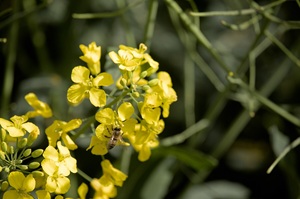Insects aren’t doing well. Several scientific studies show that three quarters of them have disappeared over the past 30 years. For instance, by agricultural practices that removed much of natural variety, and many pollinators, from the fields.

Pollinators
What can we do? The European AGRI4POL project aims to take the burden from agriculture; and to restore pollinator diversity and pollination services. The project contains 22 partners from 14 countries. It is coordinated by INRAE (the French National Research Institute for Agriculture, Food and Environment).
The aim of AGRI4POL is to make crops more attractive to pollinators such as wild bees and butterflies. This would constitute a win-win situation for both farmers and insects. For insect decline has serious consequences. Eighty per cent of agricultural crops and one-third of the agricultural production depend on pollinating insects. But yet, says Wageningen University’s Andries Temme, plant breeders have often ignored the attractiveness of flowers to pollinators. As a result, insects prefer wildflowers over crops in agriculture and horticulture; whereas wildflowers are becoming scarcer.
Insects’ decline
Modern agricultural technology has caused much of the insects’ decline. As Wageningen’s Thijs Fijen explains, there are fewer natural habitats, certainly in Europe. What remains is less diverse. Moreover, connections between natural habitats get lost. The excess of fertilizer applied to the land is also a factor. And certainly also: monoculture, the large-scale cultivation of a single crop. This creates a one-sided food supply for pollinators. Pollinating insects will have difficulty in reproducing, and that tends to reduce the yields of crops dependent on them.
Therefore, the AGRI4POL project focuses on improving the attractiveness of crops to pollinators. Agricultural crops should contribute to the recovery of pollinating insects. The problem is that we don’t exactly know what determines the attractiveness of crops to insects. It could be the amount of nectar, the amount of proteins in the pollen, or just the colour of the flowers. AGRI4POL intends to investigate all these factors. Causing flowers to be attractive to pollinating insects.
Focus on sunflowers and field beans
Within AGRI4POL, researchers from Wageningen University & Research and their French colleagues focus mainly on sunflowers and broad beans. They conduct trials that record how many insects, and which species, visit different varieties. With artificial intelligence, they analyse the images. A new approach!
Then, they will use the most attractive varieties. They don’t just plant one variety on a field, but mix various varieties – this extends the flowering period. This will prolong the pollination period and ensures higher yields. This represents a new step towards better pollination. It will also promote biodiversity – towards a system in which farmers and nature have a positive effect on each other. The ultimate goal of better agricultural practices.
Interesting? Then also read:
Neonicotinoids and bees: a heated conflict even on data
Insects are in decline, around the world. How worried should we be?
Sustainable agriculture and weed management
